
Choosing The Best Wood For Outdoor Furniture
BEAUTIFUL & DURABLE
Wood has been used for furniture as long as humans have been around—and for a good reason. Its malleability, beauty, and versatility are just as appealing today as they were hundreds of years ago. With eye-catching grains, earthy tones, and modular patterns, wood furniture creates the perfect aesthetic for any patio. What’s the best wood for outdoor furniture? How do you protect outdoor wood furniture for maximum longevity? We’ve got you covered.
When it comes to picking the best wood for outdoor furniture and protecting the pieces you already own, it really comes down to choosing the most durable species and protectants available. There is no shortage of wood varieties and sealants on the market, making choosing the best pieces and protectants a challenge.
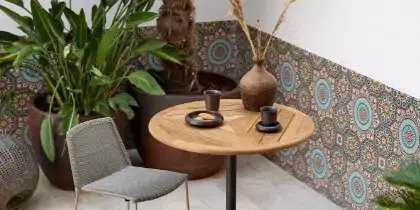
What is the best wood for outdoor furniture?
There are two types of wood that typify the wood furniture market: hardwoods and softwoods. Both are graded and offer structural and aesthetic advantages and disadvantages. As their names suggest, the main difference between the two is that hardwoods are typically stronger and denser than their softwood counterparts. Within both subgroups are weather-resistant species that are great for outdoor use. Cypress, redwood, and cedar are three softwoods that have natural moisture-wicking properties and make fine choices for outdoor furniture. But in our opinion, the best wood for outdoor furniture comes from top-of-the-line hardwoods such as cedar, acacia, eucalyptus, and teak.
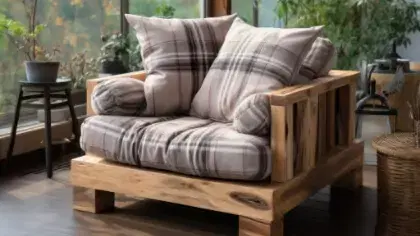
Cedar outdoor furniture
Cedar is naturally resistant to rot, decay, and pests. It’s also affordable and relatively low maintenance. Air pockets within the grain of the wood provide integrated insulation that protects against severe temperature changes and prevents warping. It’s important to note, however, that cedar does not last as long as other hardwood species, and certain softwood cedars can be easily nicked.
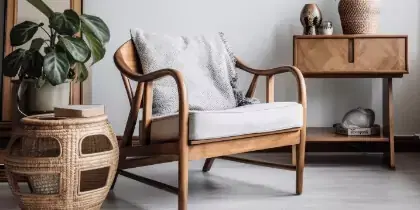
Eucalyptus outdoor furniture
Thanks to its natural resistance to rot and decay, eucalyptus is another choice for outdoor furniture. It’s also affordable and sustainable, as eucalyptus trees are a fast-growing species. However, eucalyptus outdoor furniture isn’t as durable as teak and it is prone to cracking in colder climates, even with a sealant.
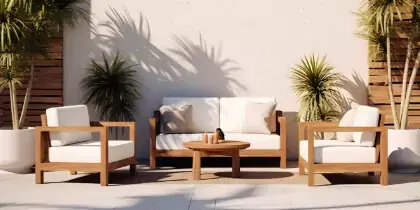
Acacia outdoor furniture
Acacia is a highly durable wood for outdoor furniture and is resistant to insects, rot, and decay. In direct sunlight, acacia wood may soften and is prone to drying out and—in high temperatures—warping. It can also be damaged by alcohol, perfumes, and certain cleaning solutions.
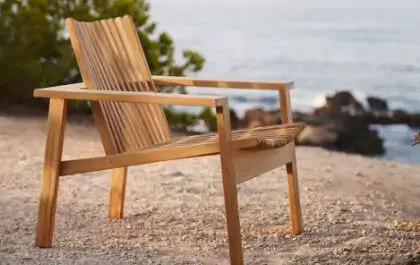
Teak outdoor furniture
A tropical hardwood, teak is one of the most beautiful and durable woods used in outdoor furniture. Teak’s natural oils are responsible for their amazing weather-resistant properties. Teak outdoor furniture will repel water, deter insects, and won’t warp with changes in humidity. Teak is also a great sustainable material for outdoor furniture. AuthenTEAK carries high-quality teak furniture from reputable brands that ensure teak furniture is made from premium-quality, responsibly harvested teak.
With time, outdoor furniture made from cedar, eucalyptus, acacia, and teak will weather out to a beautiful silver-gray color. Teak is particularly easy to restore to its original color, especially compared to other hardwoods. Many designers and homeowners will agree that this pushes teak ahead of its alternatives, making it the best wood for outdoor furniture.
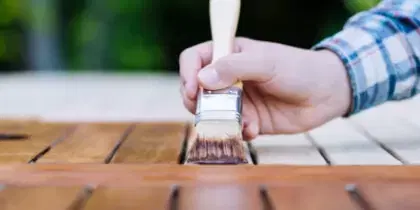
Protecting wood outdoor furniture
Most wood protectants are offered in either water or oil-based versions. In general, penetrating oil finishes are the easiest to apply and the most forgiving of errors. As the name implies, these oils are absorbed into the wood, creating a barrier against moisture and sunlight. These oils will not leave a “film” layer on the wood, making them less prone to chipping and flaking. This characteristic makes them a great protectant for outdoor furniture. You’ll probably need 2-3 coats for a dark, rich color.
Water-based protectants provide longer-lasting color retention, but there are a few things to consider first. Water-based protectants are more breathable, encouraging wood to use its natural protective properties, which can make them a great choice for wood with natural weather-resistant abilities. Unlike oil alternatives, they don’t trap moisture in the wood. These protectants are often environmentally friendly and free of toxic chemicals. They are easy to apply and clean up and are a great protector against mold, mildew, and other elements. For more information on maintaining your furniture, see our tips for teak furniture care.